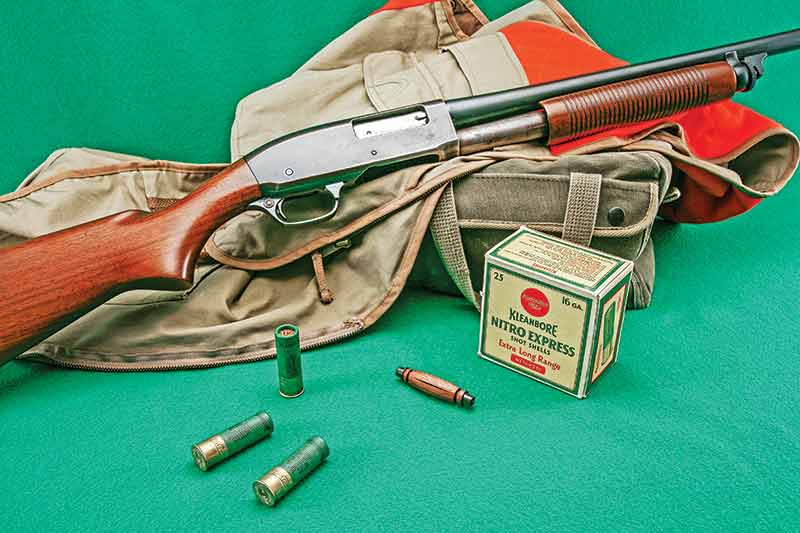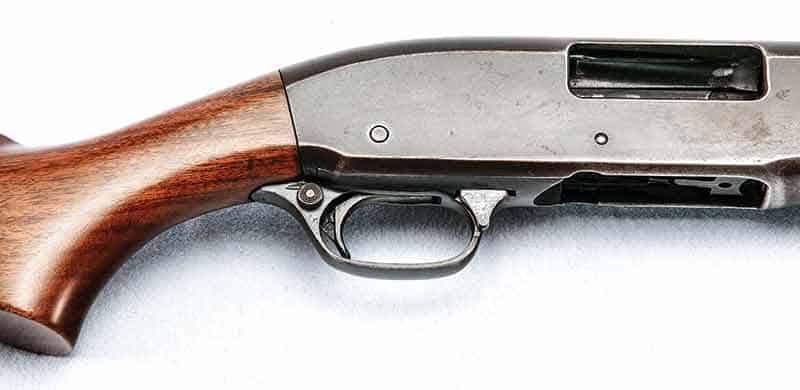Remington Model 31
The pump at its prime
It’s steep and rocky in southern Idaho — and today it was cold. I hadn’t gotten 100 yards from the truck when I was already out of breath. “Why do I keep doing this to myself?” I thought.
Suddenly a large covey of chukar flushed just below me. I quickly swung my gun just ahead of the last bird and fired. I stroked the slide on my pumpgun and a fresh shell slid into the chamber for a second try, but it wasn’t needed. The bird crumpled and fell 35 yards away. The gun? A 16-gauge Remington Model 31.
Prime Number
I’ve gone through many types of shotguns over the years. Most have been 16-gauge. I have found them to be smaller in frame, lighter in weight and equal in effectiveness to the 12-gauge yet not as long in shot pattern as the 20.
Unfortunately, the 16 isn’t as popular as it once was and ammunition — though not hard to find — is often lacking in diversity. I love pumpguns and nine years ago began exclusively using a vintage Remington M31.
Beginning Struggles
For Remington, efforts to develop a pump-action shotgun in the early 20th Century proved to be a struggle. Their first pump shotgun was the Model 10 designed by John D. Pedersen and introduced in 1908. The M10 loaded and ejected from a port underneath the receiver and provided Remington with a good start into the pump market. It was relatively popular and saw service in the trenches of WWI.
However, entry of the superlative Winchester Model 12 into the market spelled trouble for Remington. The Winchester M12 was a hugely successful side-ejection pump, which became very popular with competition shooters and hunters alike.
The Remington M10 was a good gun but was mechanically complicated and prone to breakage while shooters preferred the side-ejection feature of the Winchester M12 for the ease of single-loading a round.
Remington then introduced the Model 17 in 1921. This gun was a big improvement over the M10 with a simpler design and easier takedown, but retaining the bottom-ejection feature.
In 1929, Remington’s Crawford C. Loomis improved on the M10 and brought to market the Model 29. Still, none of these models could compete with Winchester’s M12 — whose sales far exceeded all three Remington offerings combined. Remington finally recognized the public demand for a side-ejection gun and the limited chamberings of their existing models. It fell upon Loomis to come up with a new design, with contributions from O.H. Loomis and C.H. Barnes. Development started in January 1930, and the first Remington Model 31 was shipped to distributors in August 1931.
The Model 31
The new design was based on the best attributes of the M17 but with side ejection and a simpler design than the previous models. It was initially offered in 12-gauge with 16- and 20-gauge added in 1933. Remington got it right this time. Like the M17, the barrel was easily removed by way of a knurled nut at the end of the magazine tube.
This made for easy cleaning and the barrel could quickly be swapped out, unlike the Winchester M12 where the barrel and magazine come apart as a single unit. Remington’s new gun had two frame sizes — a larger one for the 12, while the 16 bore was on a 20-gauge frame.
Now Remington had a gun on par with Winchester’s iconic M12. However, its 1931 introduction coincided with the lowest point of the Depression, which was a very tough time to start production of a high quality, relatively high-cost shotgun.
If this wasn’t enough, Remington’s retail price for the Model 31 was $48.95, while Winchester had just dropped the price of the M12 to $39.50. The high production cost of the M31 kept Remington from any meaningful reduction in retail prices for most of the pre-war years.
The M31 was made in 35 variations and grades from the Standard Grade to the TF Premier Grade with factory engraving and ventilated rib, which sold for $302 in 1931. Most grades could be ordered with a number of special options. Some 8,992 M31s were sold to the U.S. Government for use during WWII though none are known to have been used in combat. Remington also offered an aluminum frame gun starting about 1941.
The M31 had several refinements over the years so not all parts are interchangeable. The most notable change was the early guns had barrel collars. In 1941 the trigger guard was lengthened and moved back.
Pump A
Pump Action Pinnacle
Remington discontinued the M31 in 1949 after a total production of 189,243 units of which 21.3 percent were in 16-gauge and 16.5 percent in 20-gauge. During the same period Winchester produced 588,000 M12s. Interestingly, the M31 pulled within 12,000 units of annual production versus the Model 12 in the year it was discontinued.
The M31 was discontinued for the same reason the Winchester M12 was dropped 14 years later — production cost was too high and profit margins too low. The two guns, which represented the pump-action’s pinnacle of design, craftsmanship, function and beauty, were dropped in favor of more easily manufactured and more profitable designs. Remington’s status as a dark horse was to change in 1950 with the introduction of the successor to the M31. The Remington Model 870 would soon leave Winchester and the M12 in the dust.
Back To Now
My gun is a post WWII gun made in March 1947. It sports a 26″ barrel marked Improved Cylinder. Looking for a hunting, not collector, gun I wasn’t disappointed when I found the gun only retained about 65 percent of its original bluing, much of it plum brown. The stock had the original finish but also three cracks in the pistol grip, which needed to be addressed. Otherwise, the gun was “well used but not abused” and had no rust whatsoever.
Mechanically it was in great shape with a mirror-like bore. I repaired the cracks in the grip area, glass-bedded the action for additional strength, installed a 1″ Pachmayr recoil pad and refinished the wood. Then, the forcing cone was lengthened to even out patterns and reduce recoil a bit. Afterward, upon patterning the gun, I found it prints 60 percent patterns with my No. 7 reloads at 40 yards — closer to a Modified choke.
My Go-To Gun
This M31 is my all-time favorite shotgun. At 6 lbs., 12 oz., it’s a blessing to carry in the field. I love the handling of the 26″ barrel for upland game here in Idaho as the gun quickly swings into action. The stock dimensions provide a perfect, effortless sight picture for me. No shotgun handles better in my hands.
Finally, there’s the issue of smoothness. These guns do not have ball bearings but I think the description of “ball bearing action” fits perfectly. I’ve never found anything comparing to the smoothness of the M31. It has a lighter stroke than Winchester’s M12 or the Remington’s M870, which replaced it. The stroke on the M31 is the shortest of the three at 3-1/2″ inches compared to 3-3/4″ for the M12 and 3-7/8″ for the M870.
I prefer the placement of the safety behind the trigger guard compared to the forward placement on the M12. Furthermore, the slide-release button on the M12 is in an awkward position compared to the easier-to-find-release along the front right side of the trigger guard of the M31.
Don’t get me wrong — I love the M12 Winchester. If something happens to my M31 and I can’t find a replacement, you’ll find me hunting with a 26″-barreled, 16-gauge M12.
However, until that sad day, I hope never to go afield without Remington’s Model 31.
The author would like to thank Roy Marcot, President of the Remington Society of America, for key research material used in the development of this article.








